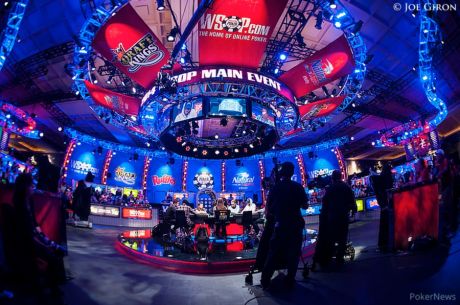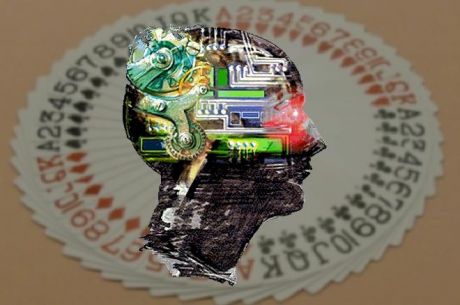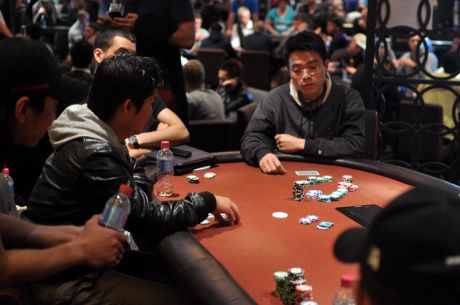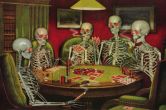On Improbable Events in Poker: Learn How to Take Your Lumps

In a weekly home game in which I frequently participate, we had a new player join the game recently. I suspect he��ll be eager to come back, because his first outing with us was one of those nights that seems statistically off the charts.
Playing no-limit hold��em with a $20 buy-in and blinds of $0.25/$0.25, he made $221 in four hours, or 221 big blinds per hour profit. Nice work if you can get it!
The main driver of his winning was an incredible number of full houses when opponents had trips, straights, and flushes. This happened enough that a couple of us kept teasingly repeating a line from Rounders:
��F*&# you and your never-ending string of boats!��
Watching such improbability come to life prompted me to think about the nature of unlikely clusters of events in poker. I thought it would be worth writing about here. My goal is not to give you any practical lessons in what to do about such improbable outcomes, but rather some insight into how to think about them.
The Probability of Improbable Luck
First, let��s try to calculate just how rare a night New Guy had, in terms of hitting full houses. Caution: there is math ahead �� but I think it��s worth knowing how to do this kind of analysis, because it can be done with all sorts of specific kinds of outcomes in poker, in gambling more generally, and even in life outside of poker and gambling. (There is such a thing, you know!)
Suppose we play 30 hands an hour. That��s 120 hands in our four-hour game. If you wanted to maximize your chances to get boats, you��d play every hand all the way out. So we need to figure the probability of a full house appearing in a random set of seven cards (your two hole cards plus the five community cards). This part of the math is too complicated for present purposes (though you can see an explanation of it here), so let��s just jump to the answer �� 0.026, or 2.6%.
In 120 hands, then, the expected number of full houses is about three. Nobody was counting, but New Guy had at least 10.
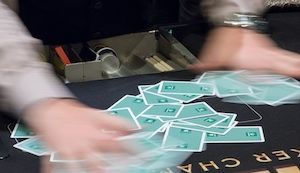
Now we��d like to know how far out of the ordinary his night really was. This requires a mathematical tool called a binomial calculator. You can find many of them online �� this one is easy to use and has a good explanation of what��s happening, should you want a deeper understanding. The inputs are ��n,�� the number of trials (120 hands); ��p,�� the probability of a full house on any one hand (0.026); and ��k,�� the target number of full houses we��re curious about (10).
The calculator spits out two useful results. The probability of getting exactly 10 full houses in 120 hands is 0.0009, or 0.09%. The probability of getting 10 or more full houses in 120 hands is very slightly more: 0.001, or 0.1%. That means if you played 120 hands per night in our home game, you could only expect to get 10 or more full houses in a session one time out of every 1,000 times you played. That��s 20 years of weekly attendance.
New Guy��s night becomes even more astonishing when you consider that he certainly didn��t play every hand. He was quite loose, and may have played half of his starting hands. (At 25 cents to enter, it��s easy to be tempted.) Of those, he obviously didn��t play all of them to the river. These factors greatly reduce the ��n�� that should be entered into the calculator, but I won��t try to churn out an answer, because I could do no more than guess at how they should be accounted for.
Still, I hope this gives you (1) the basic tools for determining the rarity of a cluster of events, and (2) a sense for how out of the ordinary New Guy��s luck was.
Having ��Average�� Luck Is Less Common Than You Think
Luck �� both good and bad �� is notoriously ��lumpy.�� Though over the long run your full houses will tend to average around 3% of the hands you play, you can be sure that they will not come every 33rd hand with clockwork precision, or anything even remotely approaching it. We can again turn to the binomial calculator to tell us about the distribution of these uncommon events.
We��ll keep our ��n�� at 120 to represent a typical poker session and our ��p�� at 0.026 for the probability of any hand turning into a boat, then we can insert various values for ��k,�� the number of full houses. Here are some of the results. (Remember that these assume, unrealistically, that you play every starting hand, and see every river.)
- Only about 4% of the time would you get through a session with no full houses; 96% of the time you��ll hit one or more.
- It��s at about seven full houses that I think your luckiness would start to really catch your attention, as this will happen only about 2% of the sessions you play.
- The most likely number of full houses you would hit is three, happening about 23% of the time. About 38% of the time you��ll have more than three, and about 39% of sessions you��ll have fewer than three.
The point here is that the most likely number of boats (three) will actually occur a relatively small minority of the time �� just under one-quarter of the four-hour games. All the other times, measured just by number of full houses, you will either be luckier or unluckier than average. Put more starkly, most of the time you will not have average luck. That is what we mean when we say that randomness produces ��lumpy�� results.
In college classes on probability, instructors will sometimes divide the class into two groups, one of which is assigned to toss a coin, say, 200 times and record the heads/tails results as a string of H��s and T��s. The other group is assigned to just make up such a string of H��s and T��s in a way that would simulate what they think tossing a coin would produce. Virtually every time, the instructor can look at the resulting strings of letters and almost immediately determine which was from the actual experimentation and which was from the group trying to emulate coin-tossing.

How does the instructor know? It��s given away by the presence or absence of long strings of H��s or T��s in the real results.
When the group just making up results gets something like HHHHH, they will almost never follow that with another H, because HHHHHH seems so obviously artificial that it would give away the fact that they��re not actually tossing a coin. But this is wrong.
Because each coin toss has an equal chance of being heads or tails, completely independent of the previous tosses, once you have HHHHH, it is just as likely that it will become HHHHHH as that it will become HHHHHT. But humans will tend not to write a string of six consecutive heads or tails; they will strongly bias the results of that sixth letter to T in an attempt to balance things out, because that��s the way we think the universe works. A fair coin has no such bias.
The actual calculation is extremely gnarly (but well explained here, for brave souls). But it works out that in 200 tosses, you will get a string of six or more consecutive heads or tails about 97% of the time �� even though the probability of any one trial of six tosses all being the same is only 1/32.
How We Deal With Improbable Seeming Deals
The point of the experiment is to show how our brains and life experience are poorly equipped to deal with things that are truly random. We tend to believe that randomness causes results that are a little irregular, but never too far out of the ordinary. The ��law of averages,�� we tell ourselves, ensures that things won��t get too much beyond the bounds of ordinariness.
The reality is far different. True randomness serves up all sorts of completely wacky, unexpected results. And the more different parameters you monitor, the more often you��ll see what appear to be anomalous coincidences.
Sure, your chance of having 10 full houses in a session may be only on the order of one in a thousand, so that particular rarity will be, well, rare. But you��ll also notice when you get pocket aces three times in a row �� or 7x2x-offsuit three times in a row.
You��ll notice if the boards keep coming up double-paired. You��ll notice if club flushes are occurring much more often that those of other suits in some session. You��ll notice if pots keep getting pushed to one end of the table a lot more than to the other. You��ll notice if four times in a row your table breaks in a tournament and you get seated just in time for the big blind at the new table. You��ll notice if the same guy wins two random hourly drawings in a poker room filled with a hundred players.
All of these results �� and a thousand more we could name �� are ��lumpy,�� and will have unlikely occurrences, just by pure chance. The only thing to do is understand that that��s the way randomness works, and accept it.
Photo (lower): ��Coin Toss,�� ICMA Photos. Creative Commons Attribution 2.0 Generic.
Robert Woolley lives in Asheville, NC. He spent several years in Las Vegas and chronicled his life in poker on the ��Poker Grump�� blog.
Want to stay atop all the latest in the poker world? If so, make sure to get PokerNews updates on your social media outlets. Follow us on Twitter and find us on both Facebook and Google+!

